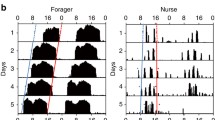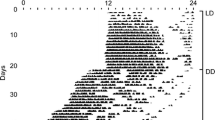Summary
The ability of social stimuli to act as entraining agents of circadian rhythms was investigated in golden hamsters (Mesocricetus auratus). In a first experiment, pairs of male hamsters (one of them enucleated and the other intact) were maintained under a light-dark (LD) cycle with a period of 23.3 h. Running-wheel activity was recorded to determine the effect of social interaction on the free-running circadian rhythm of activity. In several pairs, general activity and body temperature were also recorded. In all pairs the intact animals entrained to the LD cycle, whereas the activity rhythms of the enucleated animals free-ran with periods of approximately 24 h and showed no apparent sign of synchronization or relative coordination with the other member of the pair. In a second experiment, male hamsters maintained in constant darkness received pulses of social interaction, which have been reported to induce phase shifts of the activity rhythm. Consistent phase shifts in the running-wheel activity rhythm were not induced by the social pulses in our experiment. These results suggest strongly that social stimuli are not effective entraining agents of circadian rhythms in the golden hamster.
Similar content being viewed by others
Abbreviations
- CT :
-
circadian time
- LD :
-
light-dark
References
Aschoff J (1960) Exogenous and endogenous components in circadian rhythms. Cold Spring Harbor Symp Quant Biol 25:11–28
Aschoff J (1981) Free-running and entrained circadian rhythms. In: Aschoff J (ed) Handbook of behavioral neurobiology, vol 4. Plenum Press, New York, pp 81–94
Bovet J, Oertli EF (1974) Free-running circadian activity rhythms in free-living beaver (Castor canadensis). J Comp Physiol 92:1–10
Crowley M, Bovet J (1980) Social synchronization of circadian rhythms in deer mice (Peromyscus maniculatus). Behav Ecol Sociobiol 7:99–105
Davis FC, Stice S, Menaker M (1987) Activity and reproductive state in the hamster: independent control by social stimuli and a circadian pacemaker. Physiol Behav 40:583–590
Erkert HG, Nagel B, Stephani I (1986) Light and social effects on the free-running circadian activity rhythm in common marmosets (Callithrix jacchus; Primates): social masking, pseudosplitting, and relative coordination. Behav Ecol Sociobiol 18:443–452
Honrado GI, Mrosovsky N (1989) Arousal by sexual stimuli accelerates the re-entrainment of hamsters to phase advanced lightdark cycles. Behav Ecol Sociobiol 25:57–63
Kleinknecht S (1985) Lack of social entrainment of free-running circadian activity rhythms in the Australian sugar glider (Petaurus breviceps: Marsupialia). Behav Ecol Sociobiol 16:189–193
Marimuthu G, Rajan S, Chandrashekaran MK (1981) Social entrainment of the circadian rhythm in the flight activity of the microchiropteran bat Hipposideros speoris. Behav Ecol Sociobiol 8:147–150
Moore RY, Eichler VB (1972) Loss of circadian adrenal corticosterone rhythm following suprachiasmatic lesions in the rat. Brain Res 42:201–206
Mrosovsky N (1988) Phase response curves for social entrainment. J Comp Physiol A 162:35–46
Nelson DE, Takahashi JS (1991) Sensitivity and integration in a visual pathway for circadian entrainment in the hamster, Mesocricetus auratus. J Physiol (Lond) 439:115–145
Pittendrigh CS (1981) Circadian systems: entrainment. In: Aschoff J (ed) Handbook of behavioral neurobiology, vol 4. Plenum Press, New York, pp 95–124
Ralph MR, Foster RG, Davis FC, Menaker M (1990) Transplanted suprachiasmatic nucleus determines circadian period. Science 247:975–978
Reebs SG, Mrosovsky N (1989) Effects of induced wheel running in the circadian activity rhythms of Syrian hamsters: entrainment and phase response curve. J Biol Rhythms 4:39–48
Refinetti R, Menaker M (1992) Evidence for separate control of estrous and circadian periodicity in the golden hamster. Beh Neur Biol (in press)
Regal PJ, Connolly MS (1980) Social influences on biological rhythms. Behaviour 72:171–199
Richter CP (1970) Dependence of successful mating in rats on functioning of the 24-h clocks of the male and female. Commun Behav Biol 5:1–5
Sokolove PG, Bushell WN (1978) The chi square periodogram: its utility for analysis of circadian rhythms. J Theor Biol 72:131–160
Stephan FK, Zucker I (1972) Circadian rhythms in drinking behavior and locomoter activity of rats are eliminated by hypothalamic lesions. Proc Natl Acad Sci USA 69:1583–1586
Turek FW (1988) Do circadian biologists and chronopharmacologists talk the same “language”? Annu Rev Chronopharmacol 4:205–208
Author information
Authors and Affiliations
Rights and permissions
About this article
Cite this article
Refinetti, R., Nelson, D.E. & Menaker, M. Social stimuli fail to act as entraining agents of circadian rhythms in the golden hamster. J Comp Physiol A 170, 181–187 (1992). https://doi.org/10.1007/BF00196900
Accepted:
Issue Date:
DOI: https://doi.org/10.1007/BF00196900




